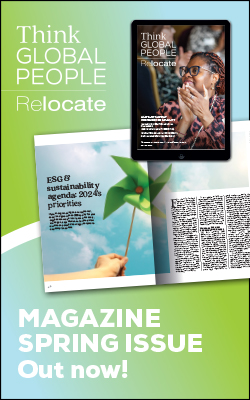Remote work is here to stay — where to next?
Post-pandemic, employees are looking to work flexibly where they can. What does this mean for future remote-working policies, asks Daida Hadzic, Director and EMA Head of Quality, Global Mobility Services, KPMG Meijburg & Co.

However things unfold, global mobility teams face significant challenges in the coming years as remote work moves from the fringes to the mainstream.
Power shifts to employees
During KPMG International’s global webcast on Work from Anywhere issues In September 2021, 530 companies from 46 jurisdictions were surveyed about their current remote working considerations and decisions. Almost 90 percent of companies said they are considering introducing a remote working policy or have already introduced one. Among these companies, the top three reasons for adopting these policies are demands from existing employees, talent shortages and the need to win in the talent market.Indeed, research shows that worker demand for remote work arrangements has become widespread. For example, in a 2021 World Economic Forum survey:
• 66 percent of respondents said they want to work flexibly when the pandemic is over
• 30 percent would consider looking for another job if they are required to return to the office full-time
• 64 percent of respondents said they were more productive with a flexible work schedule. These statistics suggests the balance of power has tipped toward employees, with a company’s remote work policies taking on ever more importance for recruitment and retention.
Remote work moves from necessity to preference
During the decade before the pandemic, only a few employees enjoyed remote working arrangements. Most employers wanted their employees to work onsite, believing this made them more able to supervise and control their workers’ activities.The pandemic proved that many employees could be just as productive, or even more so, working from home as they were in the office, but many of them also enjoyed better work-life balance and job satisfaction.
Once employees were working from home, some realised they could work just as well from anywhere. Some of them did, with or without their employer’s consent or knowledge, often unknowingly creating tax and other risks for themselves and their employers.
Where will this trend ultimately lead us? Experience has allowed companies to warm up to the idea of remote work, but the real impetus for change seems to be coming from employees, most prevalently the younger, more digitally savvy generations entering the workforce. So the current hybrid model could be seen as a compromise between older generations used to being in the workplace full-time and younger workers who want more flexible options. What remote work will look like as younger workers move up the chain of management remains to be seen.
Detachment from company premises could lead to a “self-employed” mindset, with employees working remotely for but not really seeing themselves as a part of a company. One possibility is that, for some workers, Work from Anywhere could transform into Work for Anyone. With the ability to do certain work no longer dependent on location, some people might see no reason why they can’t do their work, for example, for a couple of months in a tropical location. If the current employer won’t permit this, they may decide to find an employer that will.
What are the implications for global mobility teams?
This trend may present significant challenges for global mobility and HR teams as they work to keep their talent satisfied and productive, while also managing global tax, social security, immigration and other regulatory compliance issues that remote work brings. For example, when an employee works some or all the time in a different international jurisdiction than that of their employer, risk can arise for the employee due to tax residency rules for individuals, as well as income tax and payroll reporting requirements. Employers can face tax obligations stemming from corporate permanent establishment determinations, transfer pricing policies and corporate residency rules. While these risks are not new, they may multiply as more employees opt for remote working options. This is especially true in view of expectations that tax authorities will step up enforcement in this area now that temporary emergency remote work situations are giving way more formal arrangements. Governments are struggling to raise revenue to cover pandemic-related shortfalls and, more recently, to finance new security spending and humanitarian aid needs stemming from conflict in Europe. Experience tells us governments often intensify tax enforcement during troubled economic times. In particular, the rise of remote work has tax authorities taking more interest in enforcing compliance in cross-border employment situations, and new technological tools are helping them get much better at it. We are aware of several highly sophisticated projects at the level of the European Union and nationally using technology to compare and cross-check information related to employee movements. For example:- Business travelers coming the EU on a 90-day visa will be automatically registered at the border, allowing immigration authorities to monitor potential overstays and tax authorities to monitor days in a country to determine tax residency and establish tax liability.
- Tax authorities will have much more precise data about business travelers claiming tax-exempt days, using information from flight records, passport stamps and other sources to cross-check liability for income and payroll taxes and social security.
- By monitoring utilities, tax authorities can verify a taxpayer’s claim that a home is vacant for a certain period or, for example, being rented under the table.
Takeaways for Global Mobility leaders
In a world where employees can be hired from and work anywhere, attracting and retaining the right people is more important than ever. Employee demand means that a company’s Work from Anywhere policy could become important to its ability to compete for talent in a tight global market.Many leading global companies have adopted organization-wide policies and systems for managing the risks arising from employee movements — where they are and what they’re doing — as well as solutions to document for authorities and other stakeholders that employees adhere to these policies in practice under compliant remote work arrangements. With tax and other authorities getting more adept at analysing data on employee movements from multiple sources, it’s critical for global mobility teams to have systems in place that provide the same breadth of visibility and insight.
Read more about the Great Return in the Spring 2022 issue of Think Global People.
To explore more widely the growing importance of wellbeing at work, why not join us on 9 June for the results of the Think Global People and Relocate Awards and the Future of Work Festival?
Read more global health and wellness news here.
Subscribe to Relocate Extra, our monthly newsletter, to get all the latest international assignments and global mobility news.Relocate’s new Global Mobility Toolkit provides free information, practical advice and support for HR, global mobility managers and global teams operating overseas.
 Access hundreds of global services and suppliers in our Online Directory
Access hundreds of global services and suppliers in our Online Directory ©2024 Re:locate magazine, published by Profile Locations, Spray Hill, Hastings Road, Lamberhurst, Kent TN3 8JB. All rights reserved. This publication (or any part thereof) may not be reproduced in any form without the prior written permission of Profile Locations. Profile Locations accepts no liability for the accuracy of the contents or any opinions expressed herein.




























